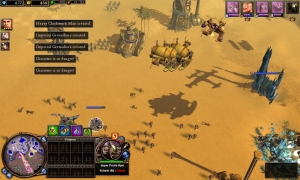Currently I’m in something of an entertainment downtime. I finished Tactics Ogre a week ago, and I’m replaying it at a leisurely pace to see one of the other storylines, but I’m not particularly engrossed in any works of fiction at the moment. Starting next week, this should change, as I have some new toys in the pipeline…
Already bought, waiting to arrive:
Section 8: Prejudice (multiplayer first-person shooter, PC) (Metacritic) – I’m not much of an FPS player, and this goes doubly so for multiplayer. But I’m making an exception for Section 8 – it comes highly recommended; it’s cheap (I paid US$13.50); and most importantly, it’s supposed to have very good bots, so I should be able to have fun playing single-player or cooperatively (as I’ve discussed with some of you guys!). Downloading this via Steam as we speak.
Jeanne d’Arc (fantasy tactical RPG, PSP) (Amazon; Metacritic) – As you probably guessed from all my Tactics Ogre coverage, tactical RPGs’ blend of RPG storytelling and squad-level strategy gameplay makes them one of my favourite game genres. Jeanne d’Arc, a fantasy game very loosely inspired by the historical heroine, is supposed to be a very good example of its genre; it’s also pretty rare, so when I saw it on sale for a pretty good price, it was a no-brainer to snap it up. My copy should arrive next week.
Persona 3 Portable (urban fantasy RPG, PSP) (Amazon – the US release, not the European collector’s edition I ordered; Metacritic) – The PSP port of a widely acclaimed PS2 RPG, in which the protagonist must juggle daily high-school life with periodic monster-fighting expeditions. While the juxtaposition of high school and life-and-death conflicts always annoys me in anime, I’m very much looking forward to seeing how this plays out in a game. This should also arrive next week.
Already pre-ordered, waiting for release:
A Game of Thrones (fantasy TV series) – HBO’s adaptation of my favourite fantasy novels. Filed under “pre-ordered” because I subscribe to the cable channel that will eventually (in July) broadcast it in Australia.
Sins of a Solar Empire: Rebellion (space opera RTS, PC) – I wrote this up in more detail back when it was announced. In addition to the usual expansion pack offering of more, and bigger, spaceships, this also comes with “new victory conditions”, which I hope could deliver a better late/endgame to Sins.
Will definitely buy when released:
A Dance with Dragons, by George R R Martin (fantasy novel) (Amazon – free shipping for Americans!) – The long-awaited next instalment in the aforementioned favourite fantasy series. I’ve waited almost six years for this book, and there’s no way I’m passing on it.
May or may not read/buy:
The Heroes, by Joe Abercrombie (fantasy novel, paperback edition – book itself has been out for a while) (Amazon): I remember seeing this book described as the “Rashomon effect” applied to a single fantasy battlefield. Abercrombie is a skilful author and I greatly enjoyed his previous books, but their extreme bleakness is starting to wear on me. I’m not sure if this book will have anything to say about the human condition that Abercrombie didn’t give us in his previous two books. We’ll see…
The Wise Man’s Fear, by Patrick Rothfuss (fantasy novel, paperback edition – book itself has been out for a while) (Amazon): Second book in a trilogy that I’ve seen described as “Harry Potter for grown-ups”, about the adventures of Kvothe the omnitalented wizard. The books have generated a fair bit of internet buzz, and I enjoyed the first book at the time, but subsequently I can barely remember a thing about book 1. Another “maybe”.
Like this:
Like Loading...



